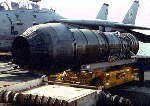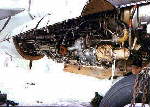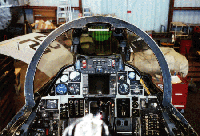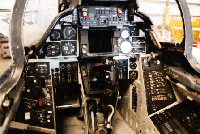 |
|
| General Characteristics: | F-14 TOMCAT | |
| Date Deployed: | First flight: December 21st 1970 | |
| Function: | Carrier-based multi-role strike fighter | |
| Type: | Class A multirole fighter | |
| Contractor: | Grumman Aerospace Corporation | |
| Unit Cost: | $38 million | |
| Propulsion: |
2x Pratt & Whitney TF30-P-414A
afterburning turbofans (F-14A) rated at 11, 700 lbs dry and 18,
900 lbs in afterburner 2x General Electric F110-GE-400 afterburning turbofans (F-14B and F-14D) rated at 16, 088 lbs dry and 27, 000 lbs in afterburner |
|
| Thrust: | F-14A: 20,900 pounds (9,405 kg) static thrust per engine; F-14B and F-14D: 27,000 pounds (12,150 kg) per engine | |
| Maximum speed: | 2.38 Mach (1,544 mph) | |
| Cruise Mach speed: | 0.72 Mach | |
| Carrier approach speed: | 125 kts |
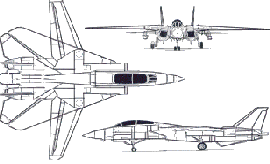 |
| Wingspan: | 64 ft 2 in (19,54 m) unswept, 38 ft (11.4 m) swept | |
| Reference wing area: | 565 sq ft. | |
| Wing aspect ratio: | 7.28 | |
| Length: | 61 ft 10 in (18.96 m) | |
| Height: | 16 ft (4.88 m) | |
| Maximum range: | 1600 nm (2573km) | |
| Combat radius: | 578 miles (930 km) | |
| Ceiling: | 68,900 ft (21,000m) | |
| Max. speed: | 1,584 mph (2,548km/h) at 40,000 ft (12,200 m) |
|
| Weights: |
Empty: 41, 780 lbs. Maximum takeoff: 74, 349 lbs. |
|
| Internal fuel: | 16, 200 lbs. | |
| External fuel: | 3, 800 lbs. | |
| Crew: | 2 - pilot and radar intercept officer | |
| Field takeoff distance: | 2500 ft. | |
| Field landing distance: | 2400 ft. | |
| Maximum external weapons load: | 15, 985 lbs. | |
| Armament: | AIM-54 Phoenix missile, AIM-7 Sparrow missile, AIM-9 Sidewinder missile, air-to-ground ordnance, and one MK-61A1 Vulcan 20mm cannon | |
|
Won US Navy VFX fighter competetion 15 January 1969; first flight of 12 development aircraft 21 December 1970; original programme was for 497 Tomcats including 12 development aircraft; programme since extended into 1990s. Initial F-14A deployed with USN squadrons VF-1 and VF-2 October 1972; total 557 including 12 development aircraft, delivered to US Navy bu April 1987, when production ended; final 102 aircraft (beginning 161, 597) delivered from FY 1983 powered by improved TF30-P-414A turbofans, having same rating as original 93 kN. |
|||||||||||||||||||||||||||||||||||||
|
Design Features Wing sweepback variable from 20° leading-edge to 68°; oversweep of 75° used for carrier storage without wing fold; wing point 2.72 m from aircraft centerline; fixed glove has dihedral to minimise cross-sectional area and reduce wave drag; small canards on F-14A known as glove vanes extend forward progressively to 15° from inboard leading-edge to balance supersonic trim change and unload tail surfaces. |
|||||||||||||||||||||||||||||||||||||
|
Flying Controls Lateral control by long-span spoilers, ahead of flaps, and tailerons; automatic leading-edge slats assist manoeuvring; strakes emerge from wing glove leading-edge at high airspeeds; automatic wing sweep has manual override; automatic scheduling of control with airspeed; autostabilisation and angle of attack protection; autopilot and automatic carrier landing system (ALCS). Airbrake panel above and below tail, between fins. Twin fins and rudders. |
|||||||||||||||||||||||||||||||||||||
|
Structure Wing carry-through is one-piece electron beam-welded structure of TI-6A1-4V titanium alloy with 6.71m span. Fuselage has machined frames, titanium main longerons and light alloy stressed skin; centre-fuselage is fuel-carrying box; radome hinges upwards for access to radar; fuel dump pipe at extreme tail; fins and rudders of light alloy honeycomb sandwich; tailplanes have multiple spars, honeycomb trailing-edges and boron/epoxy composites skins. |
|||||||||||||||||||||||||||||||||||||
|
Landing Gear Retractable tricycle type. Twin-wheel nose unit and single-wheel main units retract forward, main units inward into bottom of engine air intake trunks. Arrester hook under rear fuselage, housed in small ventral fairing. |
|||||||||||||||||||||||||||||||||||||
|
Two General Electric F110-GE-400 turbofans rated at 73.8 kN dry and 124.5 kN with afterburning. Garrett ATS200-50 air turbine started. F110 engine has 43% more reheated thrust and 37% more military thrust (without afterburning) than TF30-P-414A in F14A; results in 20% more specific excess energy;30% lower specific fuel consumption in afterburner, 62% greater deck launch intercept radius and 34% more combat air patrol time; can be launched without afterburner; time to 10,670m reduced by 61% and acceleration time; by 43%. Integral fuel tanks in outer wings, each with capacity 1,117 litres; between engines in rear fuselage, with capacity of 2,453 litres; and forward of wing carry-through structure, capacity 2,616 litres; plus two feeder tanks with combined capacity of 1,726 litres. Total internal fuel capacity 9,029 litres. An external auxiliary fuel tank can be carried beneath each intake trunk, each containing 1,011 litres. Retractable flight refuelling probe on starboard side of fuselage near front cockpit.
|
|||||||||||||||||||||||||||||||||||||
|
Accommodation Pilot and naval officer seated in tandem on Martin-Baker NACES (or GRU7A in F-14A/B) rocket-assisted zero/zero ejection seats, under a one-piece bubble canopy, hinges at the rear and offering all-round view. |
|||||||||||||||||||||||||||||||||||||
|
Avionics In F-14A, Hughes AN/AWG-9 weapons
control system, with ability to detect airbone targets at ranges
of more than 65-170nm according to their size, and ability to
track 24 enemy targets and attack six of them simultaneously
at varied altitudes and distances. Fairchild AN/AWG-15F fire
control set; CP-1066/A central air data computer; CP-1050/A computer
signal data converter; AN/ASW-27B digital data link; AN/APX-76(V)
IFF interrogator; AN/APX-72 IFF transpoder; AN/ASA-79 multiple
display indicator group; Kaiser Aerospace AN/AVG-12 vertical
and head-up display system. The Phoenix missile has a range of over 100 miles, and the Tomcat's powerful AWG-9 (F-14A) pulse-Doppler radar can track up to 6 targets at once. With the AIM-54 and AWG-9 working in tandem, the F-14 Tomcat can shoot down an aircraft without even being seen by the enemy. The AWG-9 is a pulse-Doppler, multi-mode radar with a designed capability to track 24 targets at the same time while simultaneously devising and executing fire control solutions for 6 targets. The cockpit is fitted with a Kaiser AN/AVG-12 Head-Up Display (HUD) co-located with an AN/AVA-12 vertical situation display and a horizontal situation display. A chin mounted Northrop AN/AXX-1 Television Camera Set (TCS) is used for visual target identification at long ranges. Electronic Support Measures (ESM) equipment include the Litton AN/ALR-45 radar warning and control system, the Magnavox AN/ALR-50 radar warning receiver, Tracor AN/ALE-29/-39 chaff/flare dispensers (fitted in the rear fuselage between the fins), and Sanders AN/ALQ-100 deception jamming pod. |
|||||||||||||||||||||||||||||||||||||
|
|
|||||||||||||||||||||||||||||||||||||
|
Missions 19 August 1981. Libya. Khadafi sends two Sukoi Su-22 fighter jets to take on a couple of United States fighter jet over the Gulf of Sidra. F-14 Tomcats from the carrier USS NIMITZ (CVN 68) shot down the 2 Libyan Su-22 Fitter aircraft during the encounter. On 10 October 1985, 4 F-14 Tmcats from the aircraft carrier USS SARATOGA (CV 60) forced an EgyptAir Boeing 737 to land at Sigonella Air Base in Sicily. The airliner was carrying the 4 terrorists who hijacked the cruise ship ACHILLE LAURO and killed an American. On 4 January 1989, 2 F-14 Tomcat from the carrier USS JOHN F. KENNEDY (CV 67), then off the island of Crete in the Mediterranean, intercepted 2 Libyan MiG-23 Flogger-E aircraft and downed them both, 1 with a radar-guided Sparrow AAM and the other with an IR-seeking Sidewinder. The US pilots claimed to have seen 2 parachutes. On January 15th, 1986, Khadafi challenges the US Naval forces by sending two MiG-23 Floggers to test the American military and find out how far they could push the US. The MiG's vectored on two A-6 Intruder's, after which the A-6's turned away, and two F-14 Tomcat's on CAP were sent to meet the MiG's head-on. Previous encounters with the Libyan Air Force resulted with the Libyan aircraft turning tail, and returning back to Libyan airspace. This encounter was not going to end so easily. What is probably the most publicized air-combat sequence took place and lasted over 6 minutes, an eternity to the pilots and RIO's flying the two Tomcat's involved in this battle. The end result was still the same, however. US-4, Libya-0. In late 1995, the F-14 Tomcat took on a new, and completely different role in military combat over targets in Bosnia...they became bombers. Dubbed "Bombcat's", these new bombers dropped LGB "smart bombs" while other aircraft painted the targets with lasers. |
|||||||||||||||||||||||||||||||||||||
 nose wheel light |
 lantrin pod |
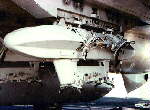 wing weapons rack |
 |
 |
